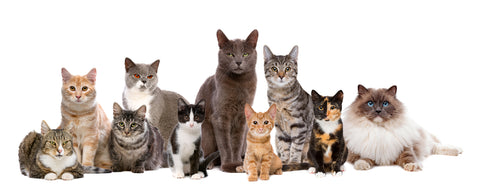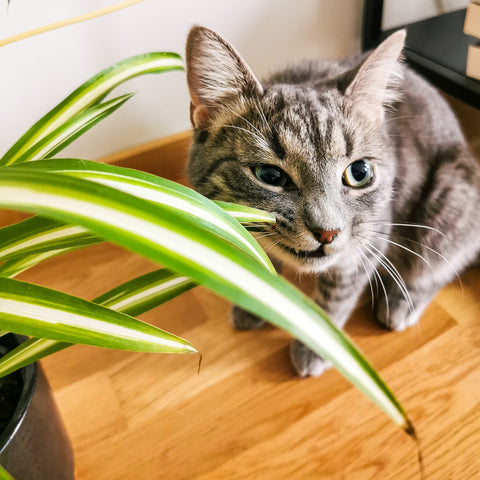
We all know that human females have menstrual cycles, which occurs when the uterus sheds its lining once every 28 days or so. If a human pregnancy occurs, the lining is retained for the growing embryo. But what about your cat? Do cats have periods? Is there such a thing as cat menstruation?
Cats are among the group of mammals that go through estrus, a process also known as "in heat." Estrus is cyclical like a period, but cats reabsorb the uterine lining instead of shedding it and bleeding.
Do Cats Have Periods?
Not exactly. Cats are induced ovulators. This means that ovulation, the process whereby eggs are stimulated and released from the ovaries, only occurs when they mate with a male cat. Humans, on the other hand, are spontaneous ovulators, which means that ovulation occurs in response to hormonal changes and happens with regular frequency.
Most female cats become reproductively mature when they are four to six months old, This is akin to human puberty. The feline estrus cycle usually lasts from seven to ten days. Humans are fertile all year, unlike cats who typically enter their estrus cycle seasonally, such as in early spring or late winter.
When your cat goes into heat, you'll notice her behavior changes to attract a mate. When a female cat (or queen) is inseminated by a male cat (the tom) she ovulates, which ends her estrus cycle and begins her pregnancy, which typically lasts around nine weeks.
When Do Cats Get Their Period?
Female cats get their period and become sexually mature when they reach puberty at around 4-6 months. Once cats are reproductively mature they can enter estrus, which is your cat’s menstrual cycle. From that point on, your young cat could have kittens of her own.

Getting your female cat spayed prevents pregnancy, so talk to your veterinarian about the appropriate time to do so.
What Are The Signs Of A Cat Having Their Period?
Felines produce chemicals called pheromones, which is how they mark their presence and make it known to other cats. Pheromones are excreted from numerous glands located in the paws, mouth, ears, face, and anus. So when your cat head butts you, she's marking you as her human.
Your cat’s behavior can change drastically while they are in heat. Your usually docile pet can turn into a destructive and demanding one that you have never seen before. If your inside cat suddenly starts bolting for an open door, she may be attempting to mark the door with pheromones to attract a suitor or run off on her own to find one herself. Even if your cat has never shown interest in the great outdoors before, that can all change during estrus, so be prepared.
The following signs can indicate that your cat is in the heat:

Loud Vocalizing
Increased vocalization is the most common sign that your cat is in a heat cycle. Incessant yowling is an invitation to male cats in the neighborhood. So guard your door unless you want a litter of kittens.
Scratching and Spraying
If your female cat has entered estrus, she will often exhibit destructive behavior, such as spraying to mark territory or indiscriminately scratching.

Increased Affection
If your kitty is in heat you may notice that she's constantly rubbing against you to the point you feel like you've grown a new appendage. Even if she’s usually a bit standoffish, estrus can bring out the love bug in your furball. Enjoy it while it lasts!
Loss Of Appetite
Some females, but not all, may have a decrease in appetite during their estrus cycle. So if your cat is eating less food than normal, it’s a normal sign of estrus and typically not a cause for concern. However, you should always consult your veterinarian should you have questions or concerns.
Meeting Position
Your cat may "assume the position" by standing in the estrus posture. This is another signal to male cats that may be in the vicinity.
Do Cats Bleed When In Heat?
Most female cats don't bleed on their period (aka while in heat) because they reabsorb their uterine lining as opposed to expelling it. However, you may notice spots of blood on the floor or in your cat's bed. This is normal during estrus and nothing to be alarmed about.
However, if there is ever blood in your cat's stool or urine, contact your veterinarian to find out if your kitty requires medical attention.
What To Do When My Cat Is In Heat
If you have never seen a cat in heat before, it can be jarring at first. Normal cat behaviors during estrus can make it seem like you suddenly have a different cat. While they are in heat, cats can feel miserable. As a pet parent, you want to ensure your kitty is as comfortable as possible. Fortunately, there are different tactics that you can try to soothe your kitty.
Keep Your Cat Warm
Some cats enjoy more warmth during their estrus cycle and like to plop on a warm, moist towel or a heat pack for relief.

Make sure it's not too hot for your baby. Additionally, you may want to provide your cat with a safe warming bed or self-warming blanket that is specifically made for cats.
Try Catnip
While some kitties are calmed by catnip during estrus, other cats are not. Offer a small amount of catnip and observe your kitty's reaction. It can’t hurt to try, and it’s better than feeling powerless while watching your fur baby writhing around and yowling.
Keep The Litter Box Clean
Cats in heat are notorious for marking their territory. This signals their availability to any males in the area.
If her litter box is clean she's more likely to leave her mark there rather than on your nice couch or bedding. A clean litter box is always a good idea to safeguard your kitty’s health.
Make Sure To Play With Your Cat
Estrus causes cats to be uncomfortable and restless. Distracting your pet with play can help ease their discomfort and give them extra time to bond with you. If your kitty is busy playing with you, they’re less likely to be shredding the sofa.
Conclusion
Considering the number of kittens languishing in shelters, the best option is getting your cat surgically sterilized (or spayed.) During a spay procedure, your cat will receive general anesthesia and your veterinarian can safely remove her ovaries and uterus. This is one way pet parents can improve the quality of life for their fur babies, as your pet won't have to endure the frustration they experience when they can’t answer nature’s biological call to breed. Spaying can also increase your cat’s longevity by decreasing the risk of breast tumors and uterine infections. Getting your female cat spayed is part of being a responsible pet parent.
There are many pawsitive results from getting your cat spayed for pet parents as well. You’ll prevent all the yowling, territory marking, and escape attempts while knowing you are safeguarding your pet’s well-being, now and in the future.
Frequently Asked Questions
Do Cats Get Periods? Not exactly. Cats don't ovulate unless they are stimulated to do so by a male cat. An estrus cycle is the feline equivalent of a human period. This is when a female cat is in heat.
Do Cats Bleed On Their Period? Cats of reproductive age reabsorb their uterine lining rather than expelling it like humans. It's normal for your cat to spot small amounts of blood.
When Do Cats Get Their Period? A female cat reaches sexual maturity around 4-6 months of age, so it’s important to keep in mind they can get pregnant beginning in that early stage. Getting your female cat spayed prevents pregnancy, so ask your veterinarian about the proper time to do so.
What Does a Cat Period Look Like? Your cat’s behavior can change drastically while they are in heat. Your usually docile pet may turn into a destructive and demanding furball that you’ve never seen before! For example, you may notice increased vocalization and destructive behaviors around the house.
Get To Know Your Cat Better With Basepaws
Basepaws DNA tests help you know your cat better—both inside and out. Discover your kitty's breed profile in relation to 21 purebred breeds. Gain insight on 25 genetic traits associated with their unique appearance and behavior, as well as potentially life-saving information about their blood type and likelihood of resistance to Feline Immunodeficiency Virus (FIV).
In addition to 43 genetic diseases, Basepaws screens your cat's oral health for their current risk of having periodontal disease, halitosis, and tooth resorption. These painful issues are difficult to see, and poor oral health puts your feline friend at risk for heart, kidney, and other health conditions. Get peace of mind with Basepaws and get ahead of diseases before they're advanced—so that your cat can live a better life, even longer.



